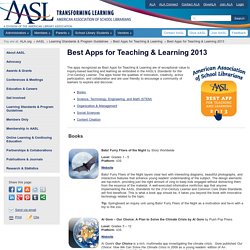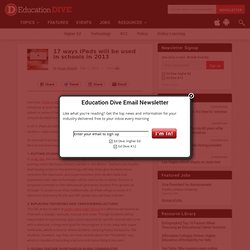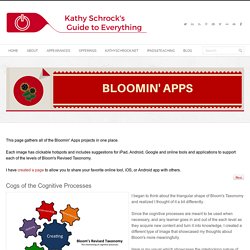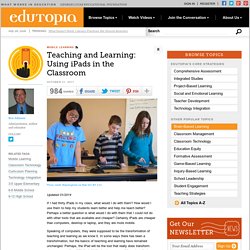

Making Digital Libraries Work, With or Without BYOD. 21st Century Libraries | February 2013 Digital Edition Making Digital Libraries Work, With or Without BYOD Districts are experimenting with strategies for creating state-of-the-art K-12 digital libraries.

By Bridget McCrea03/14/13 Three years ago, when the nation's K-12 schools started thinking seriously about creating digital libraries, the Mesquite Independent School District (TX) purchased several Sony eReaders, loaded them with books, and circulated them to students. It didn't take long for the district to see the flaws in that initial attempt. "It was a nightmare because e-readers are meant to be personal devices," recalls Debbie Swartz, library technology facilitator for the district, which serves 38,000 K-12 students. A River of Reading Those specific limitations aside, device lending is still a feasible, if imperfect, option for some schools. "It's difficult for librarians to get out of that mode of 'owning' a collection and being its gatekeepers," Corbett says. 15 Wonderful Chrome Extensions for Students.
1- Docs Quickly Create a Google Doc, Spreadsheet, Presentation, or Drawing directly from your Chrome bar.

No need to launch docs.google.com; just a single click, and you have a new document. 2- Save as PDF This extension lets you easily save web pages to pdf. It uses html to pdf online service. 3- Evernote Web Clipper Use the Evernote extension to save things you see on the web into your Evernote account. 4- Write Space Write Space is a customizable full-screen text-editor that lives in your web-browser. 5- Easy Bib Tools Automatically cite web sites with one click using the EasyBib Toolbar. 6- Todo.ly Todo.ly is an intuitive and easy to use online Todo list, and Task Manager.
If you have shared some documents with others on Google Docs, before you had to go check whether anyone's modified them. Easily share and save your attachments. 9- Send to Google Drive Allows you to upload a pdf version of the current page to your Google Drive using the pdfcrowd service. Best Apps for Teaching & Learning 2013. Science 360 by the National Science Foundation Level: ALL (grades K-12)Platform: iOS Website Science 360 is a science and engineering news app designed to engage the user in visual explorations through photos, videos, and text.

There is new content added weekly by scientists, engineers, and the National Science Foundation. Teachers can email image and videos to integrate into lesson planning. Tip: Have students explore Science 360 for possible science project ideas and explore current science in the news. 17 ways iPads will be used in schools in 2013. Last year, iPads in education took the world by storm, finding their ways into initiatives at both the K-12 and university levels.

Here at Education Dive, we talked to some of the people responsible for those rollouts and watched as schools decided how to use tablets, whether they were Apple's or not. In 2013, iPads are still going strong. New pilot programs are winning over former doubters—and in some cases existing programs are expanding. So how will iPads be used as their classroom roles evolve in 2013? Education Dive found these examples: 1. 2. 3. 4. 5. Bloomin' Apps. This page gathers all of the Bloomin' Apps projects in one place.Each image has clickable hotspots and includes suggestions for iPad, Android, Google and online tools and applications to support each of the levels of Bloom's Revised Taxonomy.I have created a page to allow you to share your favorite online tool, iOS, or Android app with others.

Cogs of the Cognitive Processes I began to think about the triangular shape of Bloom's Taxonomy and realized I thought of it a bit differently.Since the cognitive processes are meant to be used when necessary, and any learner goes in and out of the each level as they acquire new content and turn it into knowledge, I created a different type of image that showcased my thoughts about Bloom's more meaningfully.Here is my visual which showcases the interlocking nature of the cognitive processes or, simply, the "Cogs of the Cognitive Processes".
IPAD APPS TO SUPPORT BLOOM'S REVISED TAXONOMYassembled by Kathy Schrock Teaching and Learning: Using iPads in the Classroom. Updated 01/2014 If I had thirty iPads in my class, what would I do with them?

How would I use them to help my students learn better and help me teach better? Perhaps a better question is what would I do with them that I could not do with other tools that are available and cheaper? Certainly iPads are cheaper than computers, desktop or laptop, and they are more mobile. Speaking of computers, they were supposed to be the transformation of teaching and learning as we know it. Kinesthetic Learners The iPad has a number of unique features that provide for interesting possibilities in teaching and learning. As a completely portable learning tool, the iPad camera allows documentation to be taken to a whole different level. Students can also attach videos, and voice recordings to their field notes. In math class the GPS of the iPad establishes locale in ways that are profound. Connecting Beyond the Classroom.